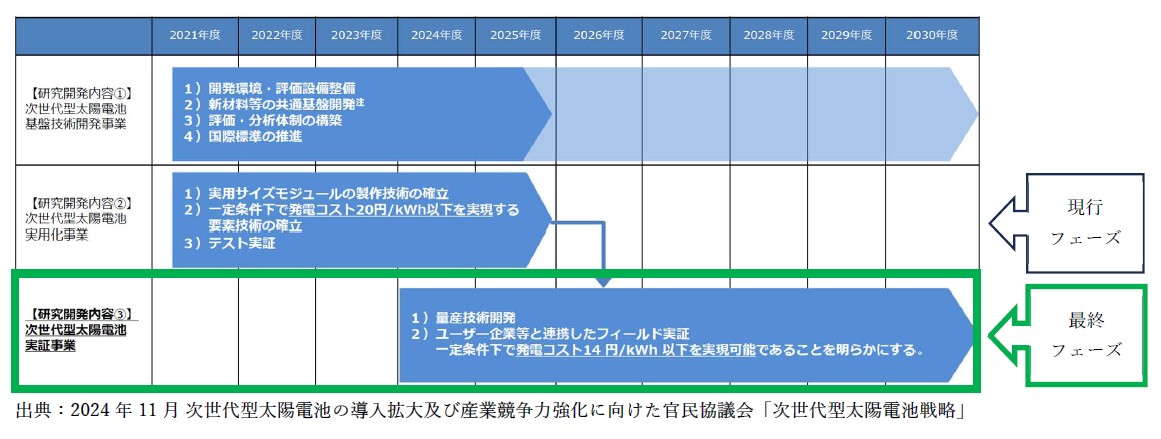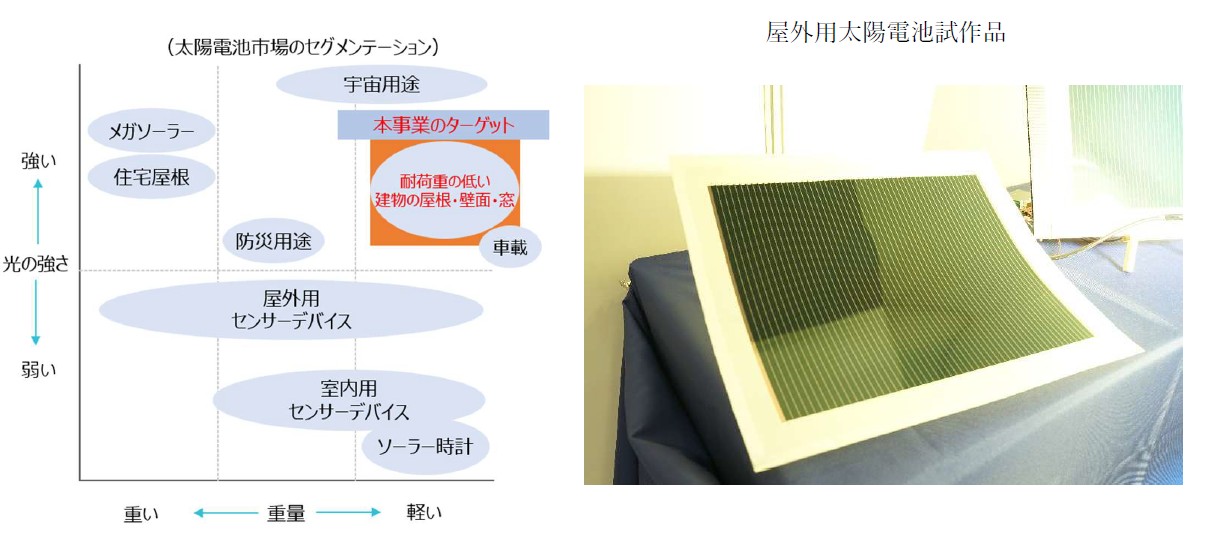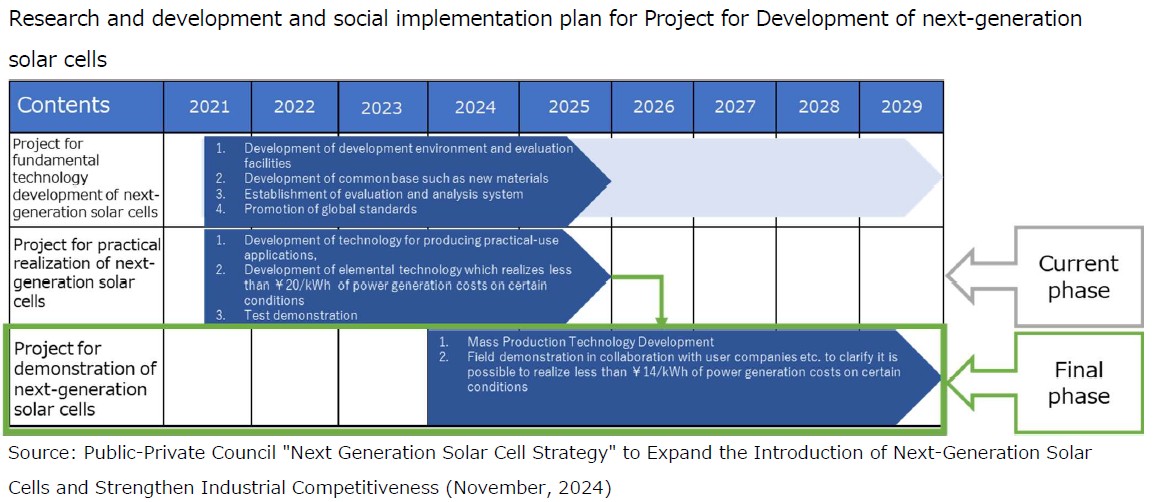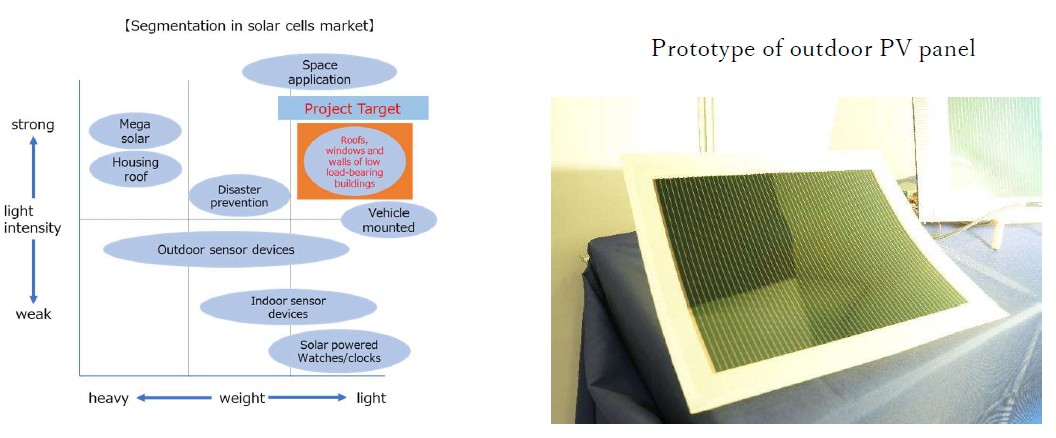
会社概要About us
NEDOグリーンイノベーション基金最終フェーズに採択されました
フィルム型ペロブスカイト太陽電池の量産技術開発を加速
屋外定置型用途に本格参入へ
株式会社エネコートテクノロジーズは、国立研究開発法人新エネルギー・産業技術総合開発機構(以下、NEDO)が公募した「グリーンイノベーション基金事業/次世代型太陽電池実証事業」に、「設置自由度の高いペロブスカイト太陽電池の社会実装に向けた量産技術開発と実証事業」(以下、本事業)を提案しておりましたが、2025 年9 月10 日に採択が公表されましたことをお知らせいたします。
本事業は、経済産業省 資源エネルギー庁が策定した『「次世代型太陽電池の開発」プロジェクトに関する研究開発・社会実装計画』における最終フェーズに該当し、2030年度までに一定条件下(日射条件等)での発電コスト14 円/kWh 以下を目指すものです。この度の採択決定によりエネコートは、現行フェーズ(次世代型太陽電池実用化事業、2021年12月28日採択)に引き続き、グリーンイノベーション基金の支援のもと、国内主要プレイヤーのうちの1社として次世代型太陽電池(ペロブスカイト太陽電池)の研究開発および社会実装に取り組むこととなりました。
「次世代型太陽電池の開発」プロジェクトに関する研究開発・社会実装計画

またエネコートは、本事業の実施を契機として巨大市場である屋外定置型用途へのペロブスカイト太陽電池による本格参入を目指します。本事業には委託先として、エネコートの起源である京都大学が参画するほか、以下の各機関と強力な企業・アカデミア連合(以下、「コンソーシアム」)を組成し、2050年までのカーボンニュートラルの実現に向けて研究開発の成果を着実に社会実装へつなげ、その後の国内外への大規模普及を進めるべく万全の体制で本事業に臨みます。さらに、本事業の実施にあたっては生産方式として創業来初めてとなる「ロールto ロール工法」の本格導入を予定しており、エネコートが得意とする「フィルム型」による市場形成を強く推進いたします。

ペロブスカイト太陽電池の開発競争は、グローバルでは既に大規模生産フェーズに移行しており、中国勢を中心に「ガラス型」で従来型の結晶シリコン系太陽電池と真っ向から対峙する構図になっています。一方で日本国内においては、軽く・薄く・曲がる(割れない)というフィルム型ペロブスカイト太陽電池の特長を活かした、結晶シリコン系太陽電池が設置できない場所(耐荷重の小さい屋根や建物壁面等)への導入による早期の市場形成が期待されており、本事業でも当該市場をターゲットとします。
日本政府が2025年2月に閣議決定した「第7次エネルギー基本計画」および経済産業省が2024年11月末に公表した「次世代型太陽電池戦略」においては、「2040年までに累積で約20GWのペロブスカイト太陽電池の導入を目指す」との明確な数値目標が示されています。これを受け日本国内においても、今後、大規模生産体制の構築に向けた競争激化が予想されますが、エネコートは上記コンソーシアムを組成して当該競争に参入し、コンソーシアムの中核的存在として研究開発をリードしていきます。

【関連リンク】
日本経済新聞:「京大発エネコート、曲がる太陽電池で産学連合 豊田合成や青学も」
PR TIMESでのプレスリリースはこちら
【本件に関するお問い合わせ先】
E-mail:info@enecoat.com
Selected for Final Phase of NEDO Green Innovation Fund
Accelerating Mass Production Technology Development for Film-Type Perovskite Solar Cells, Paving the Way for Full-Scale Entry into Outdoor Installation Applications
EneCoat Technologies Co., Ltd. (Head office: Kumiyama-cho, Kuse-gun, Kyoto Prefecture; CEO: Naoya Kato; hereinafter referred to as “EneCoat”) is pleased to announce that a project “Mass production technology development and demonstration project for the social implementation of perovskite solar cells with high installation flexibility” (hereinafter referred to as “this project”) for the “Green Innovation Fund Project/Project for Demonstration of Next-generation Solar Cells” was adopted on 10 September 2025. This project was publicly solicited by the New Energy and Industrial Technology Development Organization (hereinafter referred to as “NEDO”).
This project is the final phase of the “Research and Development and Social Implementation Plan for Project for development of next-generation solar cells” formulated by the Agency for Natural Resources and Energy, Ministry of Economy, Trade and Industry (METI) , and aims to reduce power generation costs under certain conditions (solar radiation conditions, etc.) to 14 yen/kWh or less by fiscal year 2030. Following on from the current phase (Project for practical realization of next-generation solar cells, adopted on December 28, 2021), EneCoat will be working on research and development and social implementation of next-generation solar cells (perovskite solar cells) as one of the major players in Japan, with the support of the Green Innovation Fund.

EneCoat also aims to leverage this project as an opportunity to fully enter the huge market for Selected for Final Phase of NEDO Green Innovation Fund Accelerating Mass Production Technology Development for Film-Type Perovskite Solar Cells, Paving the Way for Full-Scale Entry into Outdoor Installation Applications outdoor stationary applications with perovskite solar cells. Kyoto University, where EneCoat is originated, will participate as an outsourced entity in this project, and a powerful corporate-academia alliance (hereinafter referred to as the “Consortium”) will be formed with the following institutions.
EneCoat will be fully prepared to steadily translate the results of its research and development into social implementation toward achieving carbon neutrality by 2050, and then promote large-scale dissemination both domestically and internationally. Furthermore, the implementation of this project will see the full-scale introduction of the “roll-to-roll method” as a production method for the first time since the company’s establishment, and will strongly promote the creation of a market for the “filmtype” method, EneCoat’s specialty.

The global race to develop perovskite solar panels has already entered the large-scale production phase, with Chinese companies taking on conventional crystalline silicon solar panels with their “glasstype” solar panels. Meanwhile, in Japan, there are hopes that a market will be formed soon by taking advantage of the light, thin, and flexible (bendable) characteristics of film-type perovskite solar panels, and introducing them into places where crystalline silicon solar panels cannot be installed (such as roofs and building walls with low load-bearing capacity), and this project will target this market.
The Japanese government’s “Seventh Strategic Energy Plan,” approved by the Cabinet in February 2025, and the “Next Generation Solar Cell Strategy,” revealed by METI at the end of November 2024, set out a clear numerical target of “aiming to introduce a cumulative total of approximately 20 GW of perovskite solar cells by 2040.” In response to this, competition to build large-scale production systems is expected to intensify in Japan as well, and EneCoat has formed the above consortium to enter this competition and will lead research and development as a core member of the consortium.

【Contact for inquiries regarding this matter】
E-mail:info@enecoat.com
積雪寒冷地における耐久性を検証する共同実証実験を開始しました。
三菱HCキャピタル株式会社と北海道電力株式会社と三社合同で、これまで検証例が少ない低温環境下におけるペロブスカイト太陽電池の共同実証実験を開始しました。
プレスリリースはこちら
シリーズCラウンドの追加資金調達②を実施しました
株式会社エネコートテクノロジーズは、第三者割当増資によりシリーズC ラウンドの最終の資金調達を実施しましたのでお知らせいたします。
Achieved a conversion efficiency of over 30% with a perovskite/silicon 4-terminal tandem solar cell.
EneCoat Technologies Co., Ltd (Head Office: Kumiyama-cho, Kuze-gun, Kyoto; President: Naoya Kato) has achieved a conversion efficiency of over 30% with a 4-terminal tandem cell consisting of stacked perovskite and crystalline silicon solar cells in a joint development project with Toyota Motor Corporation. Ltd.
This achievement underscores the profound research and development capabilities of both companies in the field of perovskite solar cells and accelerates the practical application of high-efficiency solar cells, which is the objective of the joint development project.
Solar cells used in automobiles, satellites, and other applications are required to have the highest possible conversion efficiency due to the limited area available for their installation. While the theoretical conversion efficiency of perovskite solar cells alone is 33.7%, the theoretical conversion efficiency of tandem-type solar cells, which are made by stacking perovskite solar cells and crystalline silicon solar cells, is 43.8%, far exceeding the value of standalone solar cells.
Tandem solar cells have a structure with a perovskite solar cell and a crystalline silicon solar cell, each of which has its own power generation layer, in order from the light-receiving side. The perovskite solar cell first generates power with light energy in the visible light region, and the crystalline silicon solar cell generates power with light energy in the infrared region, which is not absorbed by the perovskite. The perovskite solar cell is the first to generate electricity. Therefore, perovskite solar cells are required to have both high power generation capability in visible light and the ability to transmit infrared light to crystalline silicon without loss. This time, the two companies focused on the transmittance of perovskite solar cells and succeeded in improving the infrared transmittance to 81%.

When solar cells are installed on the roof of an automobile, they are required to follow the roof shape. The two companies developed a film-type perovskite solar cell and achieved a conversion efficiency of 22.4%, which is extremely high for a see-through type solar cell. 22.4% conversion efficiency and 81% infrared transmittance have never been reported before in the world, proving the superior technology of the two companies. By combining this film-type perovskite solar cell with a crystalline silicon solar cell, we have achieved a world-class conversion efficiency of 30.4% as a 4-terminal tandem solar cell.
The conversion efficiency values obtained in this development were measured in a small area at the cell level, and we will continue to develop the large size modules of solar cells to achieve the practical application of high efficiency solar cells that will bring benefits to users.
The results will be presented at The Asia-Pacific International Conference on Perovskite, Organic Photovoltaics and Optoelectronics ( IPEROP25), which will be held on January 21 and 22, 2025, at Kyoto University’s Uji Campus.

About EneCoat Technologies
EneCoat Technologies is a startup company established in January 2018,based on the research results of Atsushi Wakamiya’s laboratory at the Institute for Chemical Research, Kyoto University. The company’s corporate mission is to contribute to the realization of a carbon-neutral society through the development of lightweight thin-film solar cells for high-illumination (outdoor) applications.
The development of solar cells for automotive applications is part of the aforementioned (2) contribution to the realization of a carbon-neutral society through lightweight thin-film solar cells for high-illumination (outdoor) applications, and we are committed to realizing a rich automotive lifestyle and reducing CO2 emissions in the automobile sector.
Press release here
Company Name : EneCoat Technologies Co.Ltd., https://www.enecoat.com/
Location: 43-1 Sako Sotoyashiki, Kumiyama-cho, Kuse-gun, Kyoto, Japan
Representative: Naoya Kato, Representative Director, Executive Officer and CEO
Capital :JPY 90 million
Business: Development, manufacture and sales of perovskite solar cells and related materials, etc.
ペロブスカイト/シリコンの4端子タンデム型太陽電池で変換効率30%超を達成
このたびトヨタ自動車株式会社との共同開発プロジェクトにおいて、ペロブスカイト太陽電池と結晶シリコン太陽電池を積層した4端子タンデムセルで30%を超える変換効率を達成いたしました。
この成果は、ペロブスカイト太陽電池分野における両社の極めて優れた研究開発能力を証明し、共同開発プロジェクトの目的である高効率太陽電池の実用化を加速するものです。
自動車や人工衛星等で使用される太陽電池は、搭載可能な面積が限定されるため可能な限り高い変換効率が求められます。ペロブスカイト太陽電池単独の理論変換効率は33.7%であるのに対し、ペロブスカイト太陽電池と結晶シリコン太陽電池を積層したタンデム型の理論変換効率は43.8%と単独型の数値をはるかに上回るため、タンデム型には高効率太陽電池として非常に高い優位性があります。
タンデム型は、受光面側から順にペロブスカイト、結晶シリコンそれぞれの発電層を持つ構造となっており、最初にペロブスカイト太陽電池が可視光領域の光エネルギーで発電し、ペロブスカイトが吸収しない赤外領域の光エネルギーで結晶シリコン太陽電池が発電します。そのため、ペロブスカイト太陽電池には、可視光での高い発電能力と赤外線をロスすることなく結晶シリコンに透過させる性能の両立が求められます。今回、両社はペロブスカイト太陽電池の透過性に着目し、赤外線透過率を81%まで向上させることに成功いたしました。

自動車のルーフに太陽電池を設置する場合、ルーフ形状に沿う必要があります。両社は、フィルム型のペロブスカイト太陽電池を用い、シースルー型としては極めて高い変換効率である22.4%を達成しました。22.4%の変換効率と81%の赤外線透過率を有するフィルム型ペロブスカイト太陽電池は世界でもこれまでに報告例が無く、両社の極めて優れた技術力を証明することができました。このフィルム型ペロブスカイト太陽電池と結晶シリコン太陽電池を組み合わせることで、タンデム型(4端子)として合計で30.4%という世界最高クラスの変換効率を達成することができました。

今回得られた変換効率の数値は、セルレベルの限定された面積での測定値であり、今後、本取り組みの成果を基盤としてモジュール化・大型化に取り組み、ユーザーメリットに優れた高効率太陽電池の実用化に向けて開発を継続してまいります。
なお、本成果は2025年1月21日、22日に京都大学宇治キャンパスで開催されるThe Asia-Pacific International Conference on Perovskite, Organic Photovoltaics and Optoelectronics (IPEROP25)において発表される予定です。
プレスリリースはこちら
シリーズCラウンド追加資金調達①を実施しました
日本初、ペロブスカイト太陽電池を活用したアートアロマディフューザーの導入を開始
株式会社エネコートテクノロジーズは、三井不動産レジデンシャル株式会社、国立大学法人京都大学とこの度、住宅におけるペロブスカイト太陽電池の活用に関する共同研究として、三井不動産レジデンシャル株式会社が2024年10月1日に新規開業したシニアレジデンス「パークウェルステイト西麻布」に設置し、実証実験を開始いたしました。
本研究は、京都大学若宮淳志教授の研究室とも連携し、産学連携でペロブスカイト太陽電池の実用化を加速するものです。
プレスリリースはこちら
■本アートアロマディフューザーについて
作者:KAARA
作品名:「廻 -まわる-」
実際に設置した様子の動画は、三井のすまい三井不動産レジデンシャルチャンネルにて視聴可能です。
動画はこちら
EneCoat Technologies Raises Series C Round, Totaling 5.5 Billion Yen Accelerating development of proprietary perovskite cell technology that can diversify solar supply chains, support IoT devices and mobility applications
シリーズCラウンドの資金調達を実施しました
株式会社エネコートテクノロジーズは、第三者割当増資により総額 55 億円のシリーズC ラウンド資金調達を完了したことをお知らせいたします。
今回の増資により、累計調達額は 80 億円を超えました。
プレスリリースはこちら